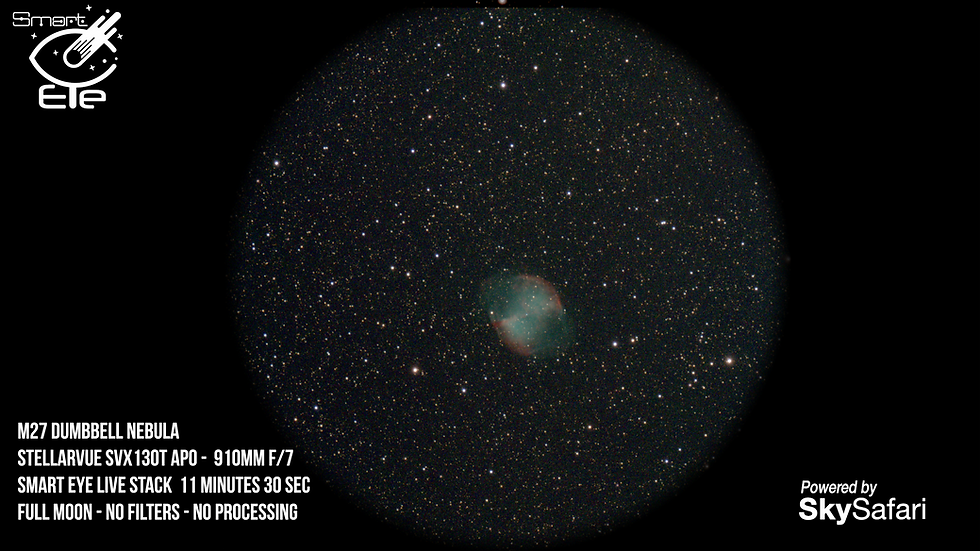Visual Astrophotography: My First Night with the SmartEye Powered by SkySafari
- David Farina

- Aug 24
- 3 min read

I’ve been a visual observer for nearly two decades, and an astrophotographer for about half of that time. I’ve seen Saturn’s rings, galaxies millions of light-years away, and nebulae glowing in the night sky. Yet, it’s been a long time since something gave me that “wow” factor I first felt when I started out in astronomy.
That changed a few nights ago when I tried the Pegasus Astro SmartEye Powered by SkySafari.
This new device bridges two worlds: it gives you the crisp, immediate experience of looking through an eyepiece, while also harnessing the power of a sensitive camera and live-stacking technology. The result is a hybrid experience—part visual astronomy, part astrophotography—that feels revolutionary.
Why the SmartEye Feels Different

Most astrophotography setups require patience: long exposures, complex alignments, and hours of post-processing. I’ll admit, while I enjoy astrophotography to a degree, it has often been more frustrating than fun.
The SmartEye is different. It allows you to look through your telescope—and what you see live is enhanced in real time. Stars remain crisp, nebulae reveal their color within minutes, and galaxies show structure that usually requires hours of imaging.
For my test, I used the Stellarvue SVX130T refractor. At f/7, it’s right at the slowest focal ratio the SmartEye recommends, but it still delivered incredible results. All of these tests were conducted under a FULL moon with no filters. The images shown are straight off the SmartEye's native LIVE stack with no post-processing.
Observing Highlights
M27 – The Dumbbell Nebula
The SmartEye’s live-stacking revealed M27 in stunning detail. Within just a couple of minutes, the familiar “dumbbell” shape emerged, and as more frames stacked, faint colors began to appear. The eyepiece view itself—projected on a high-contrast OLED screen—was strikingly natural, mimicking a traditional telescope view but with added depth.

M57 – The Ring Nebula
Watching the Ring Nebula build itself live in the eyepiece was mesmerizing. Within moments, its ghostly halo appeared, and before long, even the central white dwarf was discernible. I’ve seen this object through massive telescopes before, but seeing it unfold live from my light-polluted backyard under a full moon was jaw-dropping.

M31 – The Andromeda Galaxy
Even though the SmartEye’s sensor doesn’t capture Andromeda’s full size (it’s six full moons wide!), the galaxy’s bright core and spiral arms were unmistakable. In just ten minutes of stacking, dust lanes began to show clearly—something that normally takes hours of traditional imaging.

M33 – The Triangulum Galaxy
Fainter than Andromeda, M33 required more patience. But after about 18 minutes, spiral arms and dust lanes began to reveal themselves beautifully. This was an object I’d never expect to see this well visually through a backyard telescope. Yet here it was, as if astrophotography and eyepiece observing had merged into one.

The Hybrid Experience
One of the things I love most about the SmartEye is how it integrates seamlessly with SkySafari.
While observing, you can:
Control the camera directly from the app.
Adjust exposure, gain, sensor temperature, screen brightness, take dark frames, or even switch between mono and color modes. (Note: The sensor itself is a color sensor)
Save subframes to an SD card for later post-processing.
Plate solve images and slew the telescope mount.
Learn more with detailed descriptions, sky charts, and voice narration for select objects.
And through it all, you’re still looking through an eyepiece—not at pixels, but at an organic, natural view enhanced by technology.
Why This Matters
For me, astronomy has always been about that feeling of connection—the personal wow that happens when you see a galaxy or nebula for yourself. The SmartEye gives me that same rush I felt nearly a decade ago when I first started astrophotography. Except now, there’s no frustration. Just exploration.
Even under a full moon, in a suburban backyard, the SmartEye delivered images that rivaled what I’ve seen under some of the darkest skies in the country, like Cherry Springs State Park.
This feels like the future of amateur astronomy—making the sky accessible, immersive, and deeply personal again.
Final Thoughts
After a night with the Pegasus Astro SmartEye, I walked away genuinely impressed. It’s not perfect—large objects like Andromeda stretch beyond its field of view, and learning to look through its OLED eyepiece takes some adjustment—but the payoff is worth it.
For outreach, backyard observing, or simply reigniting your love of the night sky, this tool is a game-changer.









Comments